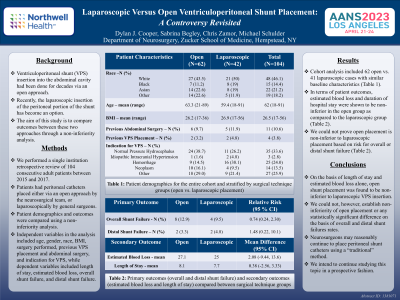Laparoscopic Versus Open Ventriculoperitoneal Shunt Placement: A Controversy Revisited
Laparoscopic versus Open Ventriculoperitoneal Shunt Placement: A Controversy Revisited
Friday, April 21, 2023


Michael Schulder, MD
Professor and VIce Chair, Department of Neurosurgery
Zucker School of Medicine at Hofstra/Northwell
Lake Success, New York, United States
ePoster Presenter(s)
Introduction: Ventriculoperitoneal (VP) shunt insertion into the abdominal cavity had been done for decades via an open approach. With recent advances in laparoscopy, insertion of the distal portion is generally performed by general surgery. The aim of this study is to compare outcomes between these two approaches.
Methods: We performed a single institution retrospective review of 103 patients between 2015 and 2020. Patients had peritoneal catheters placed either via an open approach by the neurosurgical team, or laparoscopically by general surgeons. Patient demographics and outcomes were compared between the two groups. Independent variables in the analysis included patient age, gender, race, BMI, surgery performed, previous VP shunt placement, previous abdominal procedures, and VP shunt indication, while dependent variables included length of stay (LOS), estimated blood loss (EBL), occurrence of shunt failure or malfunction within 3 months, readmission rates, and postoperative complications.
Results: Cohort analysis included 62 open vs. 41 laparoscopic cases with no significant differences between the groups regarding age, gender, race, BMI, or indication for shunt placement. The analysis showed no significant difference in outcomes between the groups.
Conclusion : Outcomes in patients who had open or laparoscopic insertion of peritoneal shunt catheters were equivalent. Neurosurgeons may reasonably continue to place peritoneal shunt catheters using a “traditional” method. We intend to continue studying this topic in a prospective fashion as our results run contrary to previous studies.
Methods: We performed a single institution retrospective review of 103 patients between 2015 and 2020. Patients had peritoneal catheters placed either via an open approach by the neurosurgical team, or laparoscopically by general surgeons. Patient demographics and outcomes were compared between the two groups. Independent variables in the analysis included patient age, gender, race, BMI, surgery performed, previous VP shunt placement, previous abdominal procedures, and VP shunt indication, while dependent variables included length of stay (LOS), estimated blood loss (EBL), occurrence of shunt failure or malfunction within 3 months, readmission rates, and postoperative complications.
Results: Cohort analysis included 62 open vs. 41 laparoscopic cases with no significant differences between the groups regarding age, gender, race, BMI, or indication for shunt placement. The analysis showed no significant difference in outcomes between the groups.
Conclusion : Outcomes in patients who had open or laparoscopic insertion of peritoneal shunt catheters were equivalent. Neurosurgeons may reasonably continue to place peritoneal shunt catheters using a “traditional” method. We intend to continue studying this topic in a prospective fashion as our results run contrary to previous studies.
